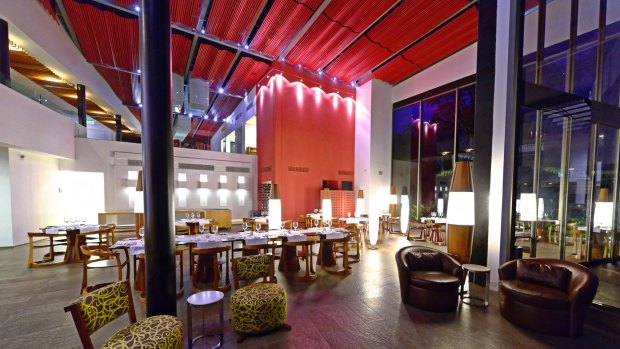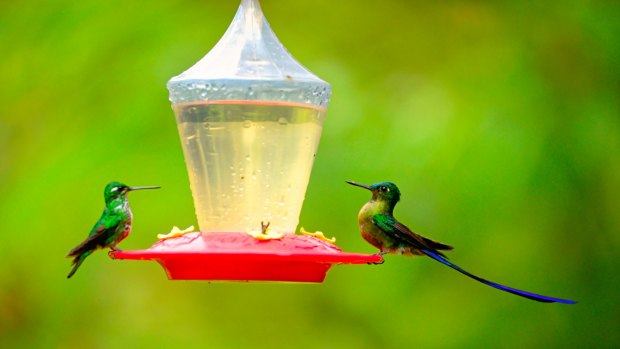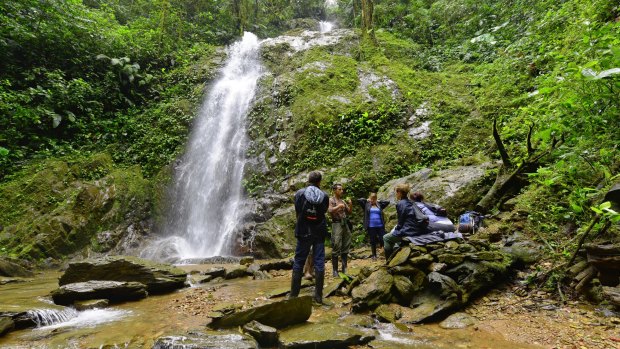This was published 10 years ago
Mashpi Lodge review, Andean Rainforest, Ecuador: Sleeping among a cloud forest
By Michael Gebicki

The splendid dining room at Mashpi Lodge.
I'm sloshing along a narrow, water-logged track through a forest ribboned with mist when a butterfly stops me dead. It's enormous, each incandescent-blue wing almost as big as a side plate. As its wings fold and unfold it looks like a hinged mirror, one moment invisible among the trees, then the wings spring apart and another flash of brilliance.
We've driven three hours from Quito to get here, past the Ciudad Mitad del Mundo, where the equator passes through Ecuador, through valleys shadowed by volcanoes and finally into an ever-more lush and misty world of tumbling waterfalls and green tendrils that drape from the misty heights of the forest canopy.
This is cloud forest, what the Ecuadoreans call Choco forest, a green band that runs along the Pacific coast from Panama in the north through Colombia, Ecuador and into Peru. It is also a biodiversity hotspot, one of the most lavishly endowed corners of the planet, with an exceptionally rich and diverse population of plants, birds, reptiles, amphibians and butterflies that are found nowhere else.

Hummingbirds are fed honeywater at the lodge's feeding station.
Its distinguishing feature is wetness. This is wet from the Bible, six metres of rainfall a year, and a constant mist that weaves its way through the trees and gives it the evocative name "cloud forest". Water is its theme song. No matter where you are in this forest you can hear water gurgling, dripping, gushing – from leaves, from streams, from countless waterfalls, from the eaves above my room.
Inserted into this waterworks, Mashpi Lodge strikes a radical pose. Most lodges in wild and unfettered places involve a fair degree of sacrifice. Comfort is suspended in the name of the experience but Mashpi is an exception. Essentially a series of steel, concrete and glass boxes, Mashpi Lodge is the fulfilment of the vision of Roque Sevilla, a former mayor of Quito and conservation zealot. More than a decade ago, Sevilla bought 1000 hectares of what had once been a logging camp in these high, misty hills, with the intention of creating an eco-lodge where visitors could share his passion for this strange and intoxicating realm. Local architect Alfredo Ribadeneira was given a tough brief which involved placing the lodge within a sensitive environment. Not one tree was to be cut down. Much of the structure was prefabricated in Quito and assembled on site to minimise impact on the forest.
Decor throughout the lodge and in the 22 guest rooms is minimalist. "This is all about creating a window on the forest," says Sevilla. "We want the lodge to be quiet but dramatic, we don't want to compete with mother nature." The dominant colour scheme is white and grey, with splashes of red. Floors are slate and local sapele wood is used for the joinery. Bathrooms have showers apart from the three suites, with leafy views from their Philippe Starck bathtubs. The effect is edgy, sleek and striking. It feels like the inside of an aquarium. Immense glass walls frame tree limbs furred with moss and ferns. By night Mashpi becomes a glowing presence in the darkness of the forest, a magnet for many thousands of insects that drum their wings against the windows, drawn to its lights.

Walkers rest at the base of one of the many waterfalls close to the lodge.Credit: Michael Gebicki
Every day the lodge organises excursions, one in the morning, another in the afternoon. On our first afternoon we're taken to the Sky Bike, a two-person caged contraption suspended from a steel cable, like a zipline, which one of you pedals, across a green chasm through the branches of rainforest trees. The first half is easy, all downhill until you reach the low point of the cable, then it's a mild thigh-burner to hoist yourselves back to the platform at the far end.
A day later we're at the Life Centre, where super-size owl butterflies, named for the spots on their wings that make them look like predators to be feared rather than fat and defenceless snacks, are draped from orchids. There are walks down steep hillsides to waterfalls (swimming optional) in the company of a naturalist who will wax lyrical on the topic of bioluminescent fungi and show you berries and seeds that the indigenous inhabitants of the forest would grind to make dyes.
Every expedition involves gumboots and rain capes, which the lodge provides. "It doesn't look like rain," I say to Jorge, my guide, thinking of my comfortable walking shoes rather than plodding gumboots for the seven kilometre trek back to the lodge from the hummingbird viewing station. He shoots me a look that a parent might give to a truculent child and I end up wearing gumboots, sloshing through puddles. Getting wet is a given, but the lodge has a drying room as effective as any ski lodge.

Road to Mashpi winds through the green tunnel of the Mashpi Biodiversity Reserve.Credit: Michael Gebicki
The forest is a musical place. Shortly after dawn, when guests are served coffee and biscuits on the roof, the lodge is assaulted by a chorus of whooping cries and trills from hundreds of feathered throats. Spotting them in the mist that clings to the branches of the cucharillo and copal trees is not easy but in a day at Mashpi we've seen a keel-billed motmot, an umbrella bird with its enormous black crop, a manakin a cock-of-the-rock, a toucan, a rose-faced parrot and tanagers.
The show-stealers are the hummingbirds, the dazzling, darting, fairy sprites of the forest. In hover mode, when feeding on the flower nectar that is its main food source, a hummingbird's wings beat 50 times every second. Should it decide to fly backwards, its wings will rev up to four times that number. A hummingbird's heart can beat more than 1000 times per minute, its lungs inflate four times per second. When food is scarce, they conserve energy by lowering their metabolic rate to less than 10 per cent of their normal activity. Even so, their capacity to store energy in their lightweight frame is so limited that a hummingbird is never far from starvation. Every morning, the hummingbird wakes with a raging appetite that must be satisfied quickly, before it drops dead.
The Andes Mountains are hummingbird central, home to around 140 species. At Mashpi, 32 species have been identified and most of those are regularly seen at the feeding station that has been set up beside the road leading to the lodge. Around a half-circle shelter, jars of sugar solution provide a drip feed for one of nature's most delicate and exquisite creations, hovering on wings that beat so fast they are invisible as they feed with delicately bowed beaks longer their bodies.
While sugar water is not entirely in keeping with the purest of ecological practice, it works. Hummingbirds come en masse. Most visitors rate the hummingbird station the highlight of their visit, and a satisfying visitor experience underwrites the commercial success of Mashpi. Without that success, yet another precious and irreplaceable bit of our planet would be gobbled up by loggers and farmers.
TRIP NOTES
MORE INFORMATION
GETTING THERE
LAN Airlines flies daily from Sydney to Santiago, Chile, with onward flights to Quito. Australian passport holders do not require a visa but all visitors to Ecuador must be vaccinated against yellow fever.
STAYING THERE
Rooms at Mashpi cost from around $1925 a night for two, including all meals. See mashpilodge.com
TOURING THERE
Metropolitan Touring, Ecuador's longest-running tour operator, can arrange trips to Mashpi Lodge. Book through the South America Tourism Office, southamericatourism.com
The writer travelled as a guest of LAN Airlines and the South America Tourism Office
Sign up for the Traveller Deals newsletter
Get exclusive travel deals delivered straight to your inbox. Sign up now.